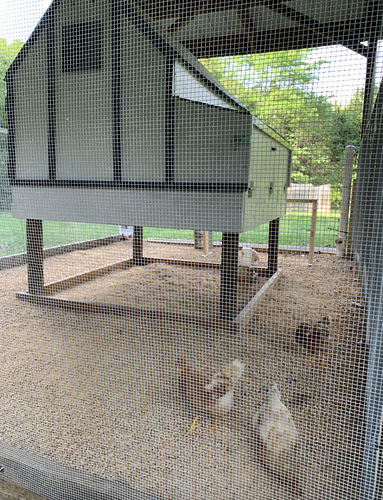The little coops you can buy at say tractor supply will keep the chickens in but predators can take them down and some don’t hold up to weather for long. I’ve read people mentioning the cost of buying them and making them predator proof was as expensive and almost as time consuming as just building something sturdier to begin with.
Our ducks and chickens used to free range during the day. Only issue was the occasional hawk.
At night they were in. We used the 2x4 welded wire on the sides and top of our outside runs. We got lazy and let them all roost where they wanted in the very well ventilated very old shed, i.e. it had large openings about 10’ on one side.
We didn’t use the 1/2" wire underground around the outside so we had to check for any signs of digging every day even though we buried large rocks around the outside . It’s a real pain to check everyday and honestly we did have something dig under it one night. Thankfully whatever it was went for the pellets. In my new run I’m burying the 1/2" mesh.
In our smaller run we used chain-link dog kennel panels on the sides and top. Easy to put up and kept out predators. Again had to keep watch for diggers.
Our chickens and most of the duck hens choose to roost in the rafters which are about 10’ off the ground (on the side without the holes). With that setup we had no problems with chicken killers for 12 years!
Then two years ago the neighbor started dismantling their abandoned barn. OMG, it seemed like overnight we got everything from that barn. Rats, fox, and mammoth racoon and skunks. I mean huge and nasty raccoon and skunks. I’ve never seen anything like them. All of them were chicken and duck killers. Horrible. We used to free range during the day. We only had the very occasional hawk issue. Now all the birds are stuck in the shed (used to hold three cars maybe 50 years ago) and outside runs 24/7. It’s big enough so they are ok, but I’m very disappointed.
When the attacks started I was unprepared for those predators. 12 years of relative peace, then chaos. I had to pick up each chicken individually at night and put them into dog crates in my big horse trailer, then herd the ducks in. Shut it up (except for ventilation) until we could shore up the shed and runs. My birds were traumatized. Fortunately it was winter and the temp was OK in the trailer at night.
We trapped and dispatched more than 15 predators. So my point is - build as predator proof as you can, predators can move in fast, even after 12 years of relative peace.
As an aside on the big live trap - we ordered what I thought was the best larger animal live trap on the market. Not inexpensive. It had to be big, so I ordered the bobcat size. The first animal we caught was one of the mammoth racoon. It ripped the trap apart the first night we put it out. Fortunately the raccoon could only pull the walls in and was still trapped. We called the company, the first person that answered actually had the nerve to tell us it wasn’t for raccoon only bobcat and they wouldn’t replace it. Really - where on earth do they think you can exclude raccoon from a live trap baited with anything. We eventually got them to replace it.





